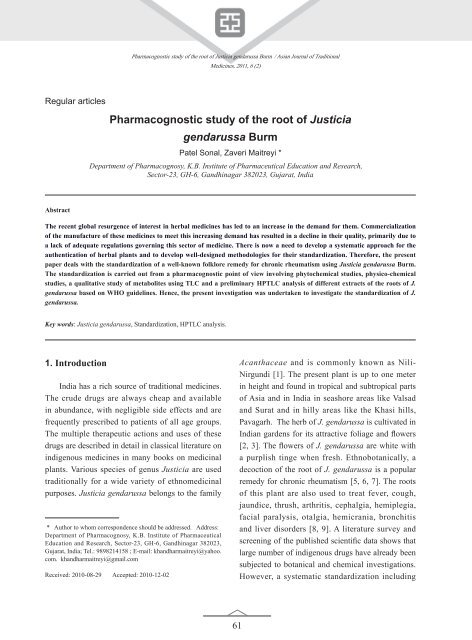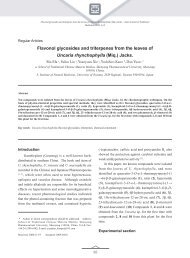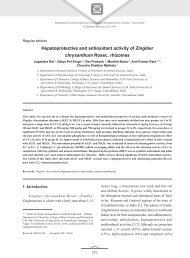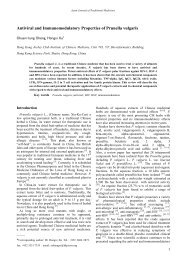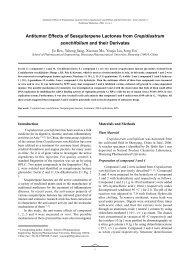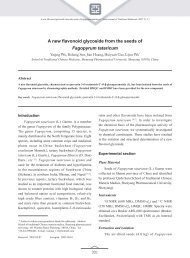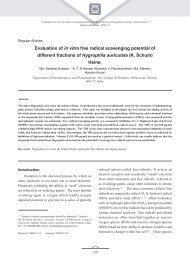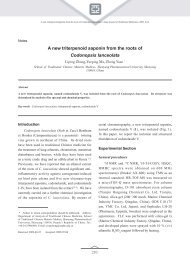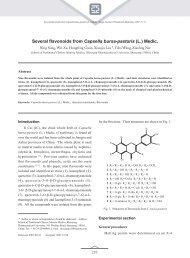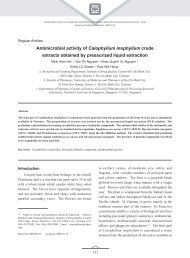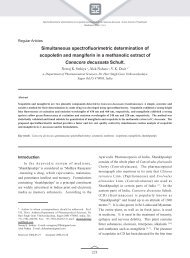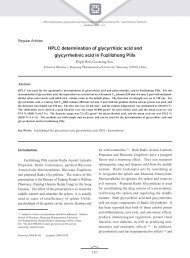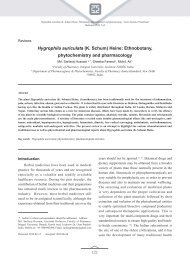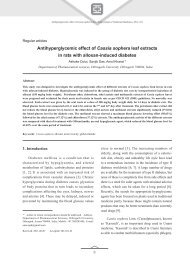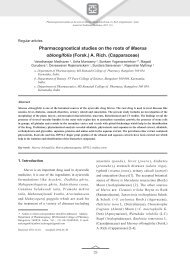Pharmacognostic study of the root of Justicia gendarussa Burm
Pharmacognostic study of the root of Justicia gendarussa Burm
Pharmacognostic study of the root of Justicia gendarussa Burm
You also want an ePaper? Increase the reach of your titles
YUMPU automatically turns print PDFs into web optimized ePapers that Google loves.
<strong>Pharmacognostic</strong> <strong>study</strong> <strong>of</strong> <strong>the</strong> <strong>root</strong> <strong>of</strong> <strong>Justicia</strong> <strong>gendarussa</strong> <strong>Burm</strong> / Asian Journal <strong>of</strong> Traditional<br />
Medicines, 2011, 6 (2)<br />
Regular articles<br />
<strong>Pharmacognostic</strong> <strong>study</strong> <strong>of</strong> <strong>the</strong> <strong>root</strong> <strong>of</strong> <strong>Justicia</strong><br />
<strong>gendarussa</strong> <strong>Burm</strong><br />
Patel Sonal, Zaveri Maitreyi *<br />
Department <strong>of</strong> Pharmacognosy, K.B. Institute <strong>of</strong> Pharmaceutical Education and Research,<br />
Sector-23, GH-6, Gandhinagar 382023, Gujarat, India<br />
Abstract<br />
The recent global resurgence <strong>of</strong> interest in herbal medicines has led to an increase in <strong>the</strong> demand for <strong>the</strong>m. Commercialization<br />
<strong>of</strong> <strong>the</strong> manufacture <strong>of</strong> <strong>the</strong>se medicines to meet this increasing demand has resulted in a decline in <strong>the</strong>ir quality, primarily due to<br />
a lack <strong>of</strong> adequate regulations governing this sector <strong>of</strong> medicine. There is now a need to develop a systematic approach for <strong>the</strong><br />
au<strong>the</strong>ntication <strong>of</strong> herbal plants and to develop well-designed methodologies for <strong>the</strong>ir standardization. Therefore, <strong>the</strong> present<br />
paper deals with <strong>the</strong> standardization <strong>of</strong> a well-known folklore remedy for chronic rheumatism using <strong>Justicia</strong> <strong>gendarussa</strong> <strong>Burm</strong>.<br />
The standardization is carried out from a pharmacognostic point <strong>of</strong> view involving phytochemical studies, physico-chemical<br />
studies, a qualitative <strong>study</strong> <strong>of</strong> metabolites using TLC and a preliminary HPTLC analysis <strong>of</strong> different extracts <strong>of</strong> <strong>the</strong> <strong>root</strong>s <strong>of</strong> J.<br />
<strong>gendarussa</strong> based on WHO guidelines. Hence, <strong>the</strong> present investigation was undertaken to investigate <strong>the</strong> standardization <strong>of</strong> J.<br />
<strong>gendarussa</strong>.<br />
Key words: <strong>Justicia</strong> <strong>gendarussa</strong>, Standardization, HPTLC analysis.<br />
1. Introduction<br />
India has a rich source <strong>of</strong> traditional medicines.<br />
The crude drugs are always cheap and available<br />
in abundance, with negligible side effects and are<br />
frequently prescribed to patients <strong>of</strong> all age groups.<br />
The multiple <strong>the</strong>rapeutic actions and uses <strong>of</strong> <strong>the</strong>se<br />
drugs are described in detail in classical literature on<br />
indigenous medicines in many books on medicinal<br />
plants. Various species <strong>of</strong> genus <strong>Justicia</strong> are used<br />
traditionally for a wide variety <strong>of</strong> ethnomedicinal<br />
purposes. <strong>Justicia</strong> <strong>gendarussa</strong> belongs to <strong>the</strong> family<br />
* Author to whom correspondence should be addressed. Address:<br />
Department <strong>of</strong> Pharmacognosy, K.B. Institute <strong>of</strong> Pharmaceutical<br />
Education and Research, Sector-23, GH-6, Gandhinagar 382023,<br />
Gujarat, India; Tel.: 9898214158 ; E-mail: khandharmaitreyi@yahoo.<br />
com. khandharmaitreyi@gmail.com<br />
Received: 2010-08-29 Accepted: 2010-12-02<br />
Acanthaceae and is commonly known as Nili-<br />
Nirgundi [1]. The present plant is up to one meter<br />
in height and found in tropical and subtropical parts<br />
<strong>of</strong> Asia and in India in seashore areas like Valsad<br />
and Surat and in hilly areas like <strong>the</strong> Khasi hills,<br />
Pavagarh. The herb <strong>of</strong> J. <strong>gendarussa</strong> is cultivated in<br />
Indian gardens for its attractive foliage and flowers<br />
[2, 3]. The flowers <strong>of</strong> J. <strong>gendarussa</strong> are white with<br />
a purplish tinge when fresh. Ethnobotanically, a<br />
decoction <strong>of</strong> <strong>the</strong> <strong>root</strong> <strong>of</strong> J. <strong>gendarussa</strong> is a popular<br />
remedy for chronic rheumatism [5, 6, 7]. The <strong>root</strong>s<br />
<strong>of</strong> this plant are also used to treat fever, cough,<br />
jaundice, thrush, arthritis, cephalgia, hemiplegia,<br />
facial paralysis, otalgia, hemicrania, bronchitis<br />
and liver disorders [8, 9]. A literature survey and<br />
screening <strong>of</strong> <strong>the</strong> published scientific data shows that<br />
large number <strong>of</strong> indigenous drugs have already been<br />
subjected to botanical and chemical investigations.<br />
However, a systematic standardization including<br />
61
<strong>Pharmacognostic</strong> <strong>study</strong> <strong>of</strong> <strong>the</strong> <strong>root</strong> <strong>of</strong> <strong>Justicia</strong> <strong>gendarussa</strong> <strong>Burm</strong> / Asian Journal <strong>of</strong> Traditional<br />
Medicines, 2011, 6 (2)<br />
pharmacognostic and physico-chemical studies is<br />
still lacking. Accordingly, <strong>the</strong> present investigation<br />
<strong>of</strong> J. <strong>gendarussa</strong> was carried out to establish<br />
botanical, chemical, and analytical tools which<br />
would help in crude drug identification as well as in<br />
checking for any adulteration. In addition, this <strong>study</strong><br />
will greatly help in quality assurance investigations<br />
<strong>of</strong> <strong>the</strong> finished products involving herbal drugs.<br />
2. Materials and methods<br />
The <strong>root</strong>s <strong>of</strong> <strong>Justicia</strong> <strong>gendarussa</strong> were collected<br />
from Anand farm and nursery Gandhinagar, Gujarat,<br />
India. The plant was au<strong>the</strong>nticated by a taxonomist<br />
at <strong>the</strong> Department <strong>of</strong> Botany, School <strong>of</strong> Science,<br />
Gandhinagar, Gujarat, India. A voucher specimen<br />
is kept at <strong>the</strong> Department <strong>of</strong> Pharmacognosy K.B.<br />
Institute <strong>of</strong> Pharmaceutical Education and Research,<br />
Gandhinagar, Gujarat. A fresh sample <strong>of</strong> <strong>the</strong> <strong>root</strong>s<br />
was subjected to morphological and microscopical<br />
studies and after <strong>the</strong> dried <strong>root</strong>s were powdered and<br />
passed through a 60 mesh sieve and <strong>the</strong>n stored<br />
in an airtight container for fur<strong>the</strong>r use. Macerates<br />
were prepared by <strong>the</strong> Schulz maceration method [7].<br />
Photomicrographs were obtained for histological<br />
observation (Labomed). A powder <strong>of</strong> <strong>the</strong> dried <strong>root</strong>s<br />
was used for chemical analysis. Physicochemical<br />
studies [9, 10] <strong>of</strong> <strong>the</strong> powdered drug, such as<br />
determination <strong>of</strong> <strong>the</strong> ash value, extractive value, loss<br />
on drying and crude fiber content were performed<br />
according to <strong>the</strong> WHO guidelines. An extract <strong>of</strong><br />
<strong>the</strong> dried <strong>root</strong> powder <strong>of</strong> <strong>Justicia</strong> <strong>gendarussa</strong> was<br />
prepared by using a soxhlet extractor involving<br />
successive extractions with increasingly polar<br />
solvents, petroleum e<strong>the</strong>r, methanol and water. The<br />
dried extracts were <strong>the</strong>n stored in airtight containers<br />
until required. These three extracts were analyzed for<br />
<strong>the</strong> presence <strong>of</strong> alkaloids [11], flavanoids [12, 13],<br />
saponins [14, 15], carbohydrates [16], steroids [17],<br />
triterpenoids [18], carotenoids, amino acids, tannins<br />
[19, 20], phenolics [21, 22], coumarins [23, 24] and<br />
anthraquinones [25] using standard procedures.<br />
2.1. Quantitative Standards<br />
2.1.1. Determination <strong>of</strong> phenolics [26, 27]<br />
To 1 ml <strong>of</strong> <strong>the</strong> methanolic extract <strong>of</strong> <strong>the</strong> <strong>root</strong>s<br />
<strong>of</strong> J. <strong>gendarussa</strong>, 10 ml distilled water and 1.5 ml<br />
diluted (1:2) Folin ciocalteu reagent were added and<br />
<strong>the</strong> mixture was allowed to stand for 5 min. After<br />
adding 4 ml 20 % w/v Na 2 CO 3 solution, <strong>the</strong> final<br />
volume was adjusted to 25 ml using distilled water.<br />
The absorbance was measured at 765 nm at intervals<br />
<strong>of</strong> 30 min up to 2 h using distilled water as a blank.<br />
The total phenol content was measured using<br />
following formula:<br />
C = (A×282.6) - 8.451<br />
where, A= Absorbance.<br />
2.1.2. Determination <strong>of</strong> saponins [28]<br />
According to <strong>the</strong> results obtained from <strong>the</strong><br />
foaming test, <strong>the</strong> foaming index <strong>of</strong> <strong>the</strong> <strong>root</strong>s <strong>of</strong> J.<br />
<strong>gendarussa</strong> was high. Fur<strong>the</strong>r studies were carried<br />
out to estimate <strong>the</strong> total saponin content. The<br />
decoction was poured into 10 stoppered test-tubes<br />
(height 16 cm, diameter 16 mm) in successive<br />
portions <strong>of</strong> 1 ml, 2 ml, 3ml. up to 10 ml, and <strong>the</strong><br />
volume <strong>of</strong> liquid in each tube was made up with<br />
water to 10 ml. The tubes were stoppered and shaken<br />
for 15 sec, at two shakes per second. After standing<br />
for 15 min, <strong>the</strong> height <strong>of</strong> <strong>the</strong> foam was measured and<br />
<strong>the</strong> froth index was calculated.<br />
2.1.3. Development <strong>of</strong> a preliminary HPTLC method<br />
for <strong>the</strong> analysis <strong>of</strong> different extracts <strong>of</strong> <strong>the</strong> <strong>root</strong>s <strong>of</strong><br />
<strong>Justicia</strong> <strong>gendarussa</strong><br />
An accurate and sensitive preliminary HPTLC<br />
method was developed for <strong>the</strong> analysis <strong>of</strong> different<br />
extracts <strong>of</strong> <strong>the</strong> <strong>root</strong>s <strong>of</strong> J. <strong>gendarussa</strong> with <strong>the</strong> help<br />
<strong>of</strong> a microliter syringe. Standard or sample solutions<br />
<strong>of</strong> appropriate volume were applied to TLC plate<br />
62
<strong>Pharmacognostic</strong> <strong>study</strong> <strong>of</strong> <strong>the</strong> <strong>root</strong> <strong>of</strong> <strong>Justicia</strong> <strong>gendarussa</strong> <strong>Burm</strong> / Asian Journal <strong>of</strong> Traditional<br />
Medicines, 2011, 6 (2)<br />
using a semiautomatic spotter (Camag Linomat V).<br />
Triplicate samples <strong>of</strong> different <strong>root</strong> extracts <strong>of</strong> J.<br />
<strong>gendarussa</strong> were spotted in <strong>the</strong> form <strong>of</strong> bands <strong>of</strong><br />
width 6 mm with a Camag 100 microlitre sample<br />
syringe (Hamilton, Bonaduz, Switzerland) on to<br />
silica gel precoated aluminum 60 F 254 , plates (20<br />
cm×10 cm) 0.2 mm thick (E. Merck, Darmstadt,<br />
Germany), using a Camag Linomat V (Switzerland)<br />
sample applicator. The plates were prewashed with<br />
methanol and activated at 110 ºC for 5 min prior to<br />
chromatography. A constant application rate <strong>of</strong> 0.1<br />
L/s was employed and space between bands was 5<br />
mm. The slit dimension was kept at 5 mm×0.45 mm<br />
and a 10 mm/sec scanning speed was employed.<br />
The monochromator bandwidth was set at 20 nm,<br />
and each track was scanned three times and a<br />
baseline correction was used. The mobile phase<br />
was toluene: methanol: formic acid (9:4.5:0.6)<br />
for <strong>the</strong> petroleum e<strong>the</strong>r extract and toluene: ethyl<br />
acetate: formic acid (5:4:1) for <strong>the</strong> hydrolysed<br />
methanolic extract and water extract and 15 ml <strong>of</strong><br />
mobile phase was used for each chromatographic<br />
separation. Linear ascending development was<br />
carried out in 20 cm×10 cm twin trough glass<br />
chambers (Camag, Muttenz, Switzerland) saturated<br />
with mobile phase. The optimum saturation time for<br />
<strong>the</strong> mobile phase was 30 min at room temperature<br />
(25 ± 2 ºC) and a relative humidity <strong>of</strong> 60 % ± 5 %.<br />
The length <strong>of</strong> <strong>the</strong> chromatographicrun was 8 cm.<br />
After development, <strong>the</strong> TLC plates were dried in a<br />
current <strong>of</strong> air with <strong>the</strong> help <strong>of</strong> an air dryer in a well<br />
ventilated wooden chamber. The flow rate in <strong>the</strong><br />
laboratory was maintained unidirectional (laminar<br />
flow, towards <strong>the</strong> exhaust system). Densitometric<br />
scanning was performed on a Camag TLC scanner<br />
V in <strong>the</strong> reflectance absorbance mode at 254, 366<br />
and 524 nm and operated using CATS s<strong>of</strong>tware (V<br />
3.15, Camag). The source <strong>of</strong> radiation used was a<br />
deuterium lamp emitting a continuous UV spectrum<br />
between 190 and 400 nm. The concentrations <strong>of</strong> <strong>the</strong><br />
Fig. 1. Morphology <strong>of</strong> J. <strong>gendarussa</strong> <strong>root</strong><br />
Fig. 1 Morphology <strong>of</strong> J <strong>gendarussa</strong> <strong>root</strong><br />
63
<strong>Pharmacognostic</strong> <strong>study</strong> <strong>of</strong> <strong>the</strong> <strong>root</strong> <strong>of</strong> <strong>Justicia</strong> <strong>gendarussa</strong> <strong>Burm</strong> / Asian Journal <strong>of</strong> Traditional<br />
Medicines, 2011, 6 (2)<br />
Fig. 2. T. S. <strong>of</strong> <strong>root</strong> <strong>of</strong> J. <strong>gendarussa</strong> (10×)<br />
Fig. 2 T. S. <strong>of</strong> <strong>root</strong> <strong>of</strong> J. <strong>gendarussa</strong> (10X)<br />
Fig. 2 T. S. <strong>of</strong> <strong>root</strong> <strong>of</strong> J. <strong>gendarussa</strong> (10X)<br />
Fig. 3. T. S. <strong>of</strong> J. <strong>gendarussa</strong> <strong>root</strong> (45×)<br />
Fig. 3 T. S. <strong>of</strong> Fig. J. 3 <strong>gendarussa</strong> T. S. <strong>of</strong> J. <strong>root</strong> <strong>gendarussa</strong> (45X)<br />
<strong>root</strong> (45X)<br />
Fig. T. S. <strong>of</strong> Fig. J. 3 <strong>gendarussa</strong> T. S. <strong>of</strong> J. <strong>root</strong> <strong>gendarussa</strong> (45X) <strong>root</strong> (45X)<br />
64
<strong>Pharmacognostic</strong> <strong>study</strong> <strong>of</strong> <strong>the</strong> <strong>root</strong> <strong>of</strong> <strong>Justicia</strong> <strong>gendarussa</strong> <strong>Burm</strong> / Asian Journal <strong>of</strong> Traditional<br />
Medicines, 2011, 6 (2)<br />
Table 1. Physico-chemical parameters <strong>of</strong> <strong>root</strong> <strong>of</strong> J. <strong>gendarussa</strong><br />
Sr No. Quality parameters Samples (%, w/w )<br />
1 Ash value<br />
a. Total ash value 10.50 ± 0.55<br />
b. Acid insoluble ash 1.89 ± 0.78<br />
c. water soluble ash 3.21 ± 0.63<br />
2 Extractive value<br />
a. Water soluble extractive 12.0 ± 0.35<br />
b. Alcohol Soluble extractive 9.10 ± 0.51<br />
c. Acetone soluble extractive 3.40 ± 0.10<br />
d. Chlor<strong>of</strong>orm extractive 2.70 ± 0.68<br />
e. Petroleum e<strong>the</strong>r extractive 2.00 ± 0.23<br />
3 Loss on drying 7.00 ± 0.14<br />
Standard deviation (SD) = ± SD , Number <strong>of</strong> readings (n) = 3<br />
Table 2. Phyto-chemical screening <strong>of</strong> different extracts <strong>of</strong> <strong>root</strong>s <strong>of</strong> J. <strong>gendarussa</strong><br />
Phytoconstituents Tests Petroleum e<strong>the</strong>r<br />
extract<br />
Methanolic<br />
extract<br />
Water extract<br />
Alkaloid Dragondr<strong>of</strong>f’s reagent test -ve +ve +ve<br />
Flavonoid<br />
Shinoda test<br />
Fluroscence test<br />
Phenolics With FeCl 3<br />
With Folin ciocalteu reagent<br />
Carbohydrates<br />
Molisch’s test<br />
Fehling test<br />
Steroids and triterpenoids Liberman burchard test<br />
Salkowski reaction<br />
Carotenoids<br />
Antimony trichloride<br />
Sulphuric acid<br />
Hydrochloric acid<br />
Tannins<br />
Test with gelatin<br />
Test with lead acetate<br />
Saponins<br />
Froth test<br />
Haemolytic zone test<br />
Coumarins<br />
With ammonia<br />
With hydroxylamine hydrochloride<br />
Anthraquinone glycoside<br />
Borntrager’s test<br />
Modified borntrager’s test<br />
-ve<br />
-ve<br />
-ve<br />
-ve<br />
-ve<br />
-ve<br />
+ve<br />
+ve<br />
-ve<br />
-ve<br />
-ve<br />
-ve<br />
-ve<br />
-ve<br />
-ve<br />
-ve<br />
-ve<br />
-ve<br />
-ve<br />
+ve<br />
+ve<br />
+ve<br />
+ve<br />
+ve<br />
+ve<br />
-ve<br />
-ve<br />
-ve<br />
-ve<br />
-ve<br />
-ve<br />
-ve<br />
+ve<br />
+ve<br />
-ve<br />
-ve<br />
-ve<br />
-ve<br />
-ve<br />
-ve<br />
+ve<br />
+ve<br />
+ve<br />
+ve<br />
-ve<br />
-ve<br />
-ve<br />
-ve<br />
-ve<br />
-ve<br />
-ve<br />
+ve<br />
+ve<br />
-ve<br />
-ve<br />
-ve<br />
-ve<br />
chromatographed compounds were determined from<br />
<strong>the</strong> intensity <strong>of</strong> <strong>the</strong> diffused light. The plate with<br />
<strong>the</strong> petroleum e<strong>the</strong>r extract plate was sprayed with<br />
anisaldehyde sulphuric acid reagent while <strong>the</strong> plates<br />
with <strong>the</strong> methanolic and water extracts plates were<br />
sprayed with phenol reagent.<br />
Standard preparation: A solution <strong>of</strong> 1mg/ml<br />
lupeol and β-sitosterol was prepared in petroleum<br />
e<strong>the</strong>r.<br />
Sample preparation: A 1 mg/ml solution<br />
<strong>of</strong> <strong>the</strong> petroleum e<strong>the</strong>r extract <strong>of</strong> J. <strong>gendarussa</strong><br />
65
<strong>Pharmacognostic</strong> <strong>study</strong> <strong>of</strong> <strong>the</strong> <strong>root</strong> <strong>of</strong> <strong>Justicia</strong> <strong>gendarussa</strong> <strong>Burm</strong> / Asian Journal <strong>of</strong> Traditional<br />
Medicines, 2011, 6 (2)<br />
Fig. 4 Powder <strong>study</strong> <strong>of</strong> <strong>root</strong> <strong>of</strong> J. <strong>gendarussa</strong>.<br />
Table 3. Estimation <strong>of</strong> phytoconstituents in <strong>root</strong> <strong>of</strong> J.<br />
<strong>gendarussa</strong><br />
Sr.<br />
Phytoconstituents<br />
No.<br />
1 Phenolics<br />
(methanolic)<br />
2 Saponins Foaming<br />
Index<br />
(water extract)<br />
Value<br />
1.02 % ± 0.02 % (w/w )<br />
111.00 ± 0.00<br />
Standard deviation (SD) = ± SD , Number <strong>of</strong> readings (n) = 3<br />
Fig. 4. Powder <strong>study</strong> <strong>of</strong> <strong>root</strong> <strong>of</strong> J. <strong>gendarussa</strong><br />
Fig. 4 Powder <strong>study</strong> <strong>of</strong> <strong>root</strong> <strong>of</strong> J. <strong>gendarussa</strong>.<br />
Fig. Powder <strong>study</strong> <strong>of</strong> <strong>root</strong> <strong>of</strong> J. <strong>gendarussa</strong>.<br />
was prepared in petroleum e<strong>the</strong>r, while a 1 mg/ml<br />
solution <strong>of</strong> <strong>the</strong> hydrolyzed methanolic extract and<br />
hydrolyzed water extract <strong>of</strong> J. <strong>gendarussa</strong> was<br />
prepared in chlor<strong>of</strong>orm.<br />
Preparation <strong>of</strong> <strong>the</strong> hydrolyzed methanolic<br />
extract and hydrolyzed water extract: 1 g <strong>of</strong> <strong>the</strong><br />
methanolic extract <strong>of</strong> <strong>the</strong> <strong>root</strong>s <strong>of</strong> J.<strong>gendarussa</strong> and<br />
1 g <strong>of</strong> <strong>the</strong> water extract <strong>of</strong> <strong>the</strong> <strong>root</strong>s <strong>of</strong> J.<strong>gendarussa</strong><br />
were refluxed separately with 1 N hydrochloric acid<br />
66
HPTLC plate scanned at at 459 nm<br />
<strong>Pharmacognostic</strong> <strong>study</strong> <strong>of</strong> <strong>the</strong> <strong>root</strong> <strong>of</strong> <strong>Justicia</strong> <strong>gendarussa</strong> <strong>Burm</strong> / Asian Journal <strong>of</strong> Traditional<br />
Medicines, 2011, 6 (2)<br />
HPTLC plate scanned at 459 nm<br />
HPTLC plate scaned at 459 nm<br />
R ff<br />
Relative<br />
area (%)<br />
0.58 R f<br />
Relative<br />
14.54<br />
area (%)<br />
0.70<br />
0.58 11.70<br />
14.54<br />
R 0.81 f<br />
0.70 12.27<br />
11.70<br />
Relative area<br />
(%)<br />
0.58 14.54<br />
0.70 11.70<br />
0.81 12.27<br />
0.81 12.27<br />
Plate scanned at at 366 nm<br />
HPTLC plate scaned at 366 nm<br />
Plate scanned at 366 nm<br />
0AU<br />
700<br />
600<br />
500<br />
400<br />
300<br />
200<br />
100<br />
0.00 0-10 0.20 0.30 0.40 0.50 0.60 0.70 0.80 0.90 R f<br />
Fig. 5. HPTLC analysis <strong>of</strong> methanolic extract <strong>of</strong> <strong>root</strong> <strong>of</strong> J .<strong>gendarussa</strong><br />
R ff<br />
Relative<br />
area (%)<br />
Relative<br />
0.31 R f<br />
14.99<br />
Relative area (%) area<br />
R f<br />
(%)<br />
0.56 8.27<br />
0.31 0.58 14.54 14.99<br />
11.70<br />
0.70 38.97<br />
0.56 0.81 12.27 8.27<br />
0.87 16.06<br />
0.70 38.97<br />
0.87 16.06<br />
(HCl) on a water bath for 30 min. Then, <strong>the</strong> acidic<br />
extract was separated using chlor<strong>of</strong>orm and <strong>the</strong><br />
chlor<strong>of</strong>orm layer was collected, concentrated and<br />
used for sample preparation for HPTLC analysis.<br />
Fig. 5 HPTLC analysis <strong>of</strong> <strong>of</strong> methanolic extract <strong>of</strong> <strong>of</strong> <strong>root</strong> <strong>of</strong> <strong>of</strong> J.<strong>gendarussa</strong><br />
Fig. 5 HPTLC analysis <strong>of</strong> methanolic extract 3.2. Microscopy <strong>of</strong> <strong>root</strong> <strong>of</strong> J.<strong>gendarussa</strong><br />
3. Results<br />
3.1. Macroscopy<br />
The shade-dried intact <strong>root</strong>s <strong>of</strong> <strong>Justicia</strong><br />
<strong>gendarussa</strong> (Fig. 1) are 10-20 cm long with a<br />
diameter <strong>of</strong> 0.1 to 0.5 cm. The outer surface is<br />
grayish white in colour with nodules, while <strong>the</strong> outer<br />
surface has longitudinal wrinkles, transverse cracks<br />
and <strong>root</strong> scars. The wood is smooth and yellowish<br />
white in colour.<br />
The transverse section <strong>of</strong> <strong>the</strong> J. <strong>gendarussa</strong> <strong>root</strong>s<br />
appears almost circular.<br />
Cork cell (CK): The cork <strong>of</strong> J.<strong>gendarussa</strong><br />
consists <strong>of</strong> 2-3 layers. The cells are radially<br />
elongated, tubular and compactly arranged.<br />
67
HPTLC Plate scanned at at 254 nm<br />
HPTLC Plate scanned at 254 nm<br />
HPTLC plate scaned at 254 nm<br />
<strong>Pharmacognostic</strong> <strong>study</strong> <strong>of</strong> <strong>the</strong> <strong>root</strong> <strong>of</strong> <strong>Justicia</strong> <strong>gendarussa</strong> <strong>Burm</strong> / Asian Journal <strong>of</strong> Traditional<br />
Medicines, 2011, 6 (2)<br />
[mm]<br />
HPTLC Plate scanned at at 366 nm<br />
HPTLC plate scaned at 365 nm<br />
AU<br />
HPTLC Plate scanned at 366 nm<br />
200.0<br />
150.0<br />
800.0<br />
600.0<br />
100.0<br />
400.0<br />
50.0<br />
200.0<br />
0.0<br />
0.0<br />
0.00 0-10 0.20 0.30 0.40 0.50 0.60 0.70 0.80 0.90 R f<br />
1000.0<br />
800.0<br />
600.0<br />
400.0<br />
200.0<br />
0.0<br />
AU<br />
R f<br />
Relative<br />
area (%)<br />
0.58 14.54<br />
0.70 11.70<br />
0.81 12.27<br />
R f<br />
Relative<br />
area (%)<br />
0.09 24.61<br />
0.16 46.84<br />
0.29 11.64<br />
0.46 10.29<br />
Fig. 6. HPTLC analysis <strong>of</strong> petroleum e<strong>the</strong>r extract <strong>of</strong> <strong>root</strong> <strong>of</strong> J. <strong>gendarussa</strong><br />
Cortex (CT): The major part <strong>of</strong> <strong>the</strong> section<br />
is made <strong>of</strong> <strong>the</strong> cortex. The outer 2-3 layers are<br />
compact. The cells are spherical to oval, thin<br />
walled and a few smaller intercellular spaces are<br />
present. The rest <strong>of</strong> <strong>the</strong> region comprises large air<br />
chambers, separated from one ano<strong>the</strong>r by thin walled<br />
parenchymatous tissues called aerenchyma, arranged<br />
in uniseriate rows. The air chambers are large and<br />
occur toward <strong>the</strong> periphery and <strong>the</strong>ir size decreases<br />
gradually towards <strong>the</strong> centre. Stone cells are also<br />
present singly or in groups.<br />
Endodermis: A distinct, single layer <strong>of</strong><br />
endodermis separates <strong>the</strong> cortical region from<br />
<strong>the</strong> vascular region and <strong>the</strong>re is a reticulate<br />
parenchymatous cell which is lignified.<br />
Fig. 6 HPTLC analysis <strong>of</strong> <strong>of</strong> petroleum e<strong>the</strong>r extract <strong>of</strong> <strong>of</strong> <strong>root</strong> <strong>of</strong> <strong>of</strong> J. J. <strong>gendarussa</strong><br />
Vascular tissue: The vascular bundle is<br />
collateral and conjoint. The phloem (Ph) region has<br />
phloem collenchymatous cells and phloem fibers<br />
which are in groups. The xylem (Xy) has xylem<br />
vessels, tracheids, xylem fibres and medullary rays.<br />
The medullary rays are uni-seriate to bi- or triseriate<br />
and <strong>the</strong> central region has lignified xylem<br />
parenchymatous cells and pith is also present which<br />
shows <strong>the</strong> characteristics <strong>of</strong> hydrophytes as shown in<br />
Fig. 2-4.<br />
Fig. 6 HPTLC analysis <strong>of</strong> petroleum e<strong>the</strong>r extract <strong>of</strong> <strong>root</strong> <strong>of</strong> J. <strong>gendarussa</strong><br />
68
HPTLC HPTLC plate plate scanned plate scanned at 524 at at nm 524 nm nm<br />
<strong>Pharmacognostic</strong> <strong>study</strong> <strong>of</strong> <strong>the</strong> <strong>root</strong> <strong>of</strong> <strong>Justicia</strong> <strong>gendarussa</strong> <strong>Burm</strong> / Asian Journal <strong>of</strong> Traditional<br />
Medicines, 2011, 6 (2)<br />
HPTLC plate scaned at 524 nm<br />
R f<br />
Relative<br />
area (%)<br />
0.14 6.80<br />
0.26 4.65<br />
0.35 2.45<br />
0.50 16.43<br />
0.77 21.44<br />
0.81 8.24<br />
0.91 33.85<br />
Co- Co- chromatography <strong>of</strong> with lupeol and β – sitosterol<br />
Co-chromatography <strong>of</strong> with <strong>of</strong> with lupeol lupeol and β-sitosterol and β – sitosterol<br />
Co- chromatography <strong>of</strong> with lupeol and β – sitosterol<br />
Fig. 7. HPTLC analysis <strong>of</strong> petroleum e<strong>the</strong>r extract <strong>of</strong> <strong>root</strong> <strong>of</strong> J. <strong>gendarussa</strong>.<br />
The physico-chemical standard parameters, like<br />
ash values, extractive values and loss on drying, are<br />
shown in Table 1.<br />
Phytochemical screening showed <strong>the</strong> presence<br />
<strong>of</strong> phenolics, steroids, triterpenoids, carotenoids, and<br />
Fig saponins . Fig 7 HPTLC . in 7 different HPTLC analysis extract analysis as <strong>of</strong> shown petroleum <strong>of</strong> in petroleum Table 2. e<strong>the</strong>r e<strong>the</strong>r extract extract <strong>of</strong> <strong>root</strong> <strong>of</strong> <strong>of</strong> <strong>root</strong> J. <strong>of</strong> <strong>gendarussa</strong> J. <strong>gendarussa</strong><br />
The methanolic extract <strong>of</strong> <strong>the</strong> <strong>root</strong>s <strong>of</strong> J.<br />
<strong>gendarussa</strong> contain large amounts <strong>of</strong> phenolics<br />
while <strong>the</strong> water extract <strong>of</strong> <strong>the</strong> <strong>root</strong>s <strong>of</strong> J.<strong>gendarussa</strong><br />
contain less saponins as shown in Table 3.<br />
The extracts were standardized using HPTLC<br />
analysis. The HPTLC chromatogram <strong>of</strong> <strong>the</strong><br />
petroleum e<strong>the</strong>r extract <strong>of</strong> <strong>the</strong> <strong>root</strong>s <strong>of</strong> J. <strong>gendarussa</strong><br />
contained 9 peaks with R f values <strong>of</strong> 0.14, 0.26, 0.35,<br />
0.50, 0.77, 0.81, and 0.91 along with lupeol (0.50 R f )<br />
and β-sitosterol (0.35 R f ) after derivatization with<br />
anisaldehyde sulphuric acid and <strong>the</strong> methanolic<br />
extract <strong>of</strong> <strong>the</strong> <strong>root</strong>s showed 4 peaks at R f values <strong>of</strong><br />
0.31, 0.56, 0.70, and 0.87 and <strong>the</strong> water extract <strong>of</strong><br />
<strong>the</strong> <strong>root</strong>s showed 6 peaks at R f values <strong>of</strong> 0.12, 0.25,<br />
0.40, 0.58, 0.63, and 0.89 at 366 nm as shown in<br />
Fig . 7 HPTLC analysis <strong>of</strong> petroleum e<strong>the</strong>r extract <strong>of</strong> <strong>root</strong> <strong>of</strong> J. <strong>gendarussa</strong><br />
Fig. 5-8.<br />
69
HPTLC plate scanned at 254 nm<br />
HPTLC plate scanned at 254 nm<br />
HPTLC plate scanned at 254 nm<br />
HPTLC plate scaned at 254 nm<br />
<br />
<strong>Pharmacognostic</strong> <strong>study</strong> <strong>of</strong> <strong>the</strong> <strong>root</strong> <strong>of</strong> <strong>Justicia</strong> <strong>gendarussa</strong> <strong>Burm</strong> / Asian Journal <strong>of</strong> Traditional<br />
Medicines, 2011, 6 (2)<br />
R f Area (%)<br />
0.29 13.76<br />
0.55 14.41<br />
0.78 13.05<br />
0.89 22.45<br />
HPTLC HPTLC plate plate scanned at at 366nm<br />
HPTLC plate scanned at 366nm<br />
HPTLC plate scaned at 366 nm<br />
AU<br />
AU<br />
400.0<br />
350.0<br />
300.0<br />
250.0<br />
200.0<br />
150.0<br />
100.0<br />
50.0<br />
0.0<br />
0.00 0-10 0.20 0.30 0.40 0.50 0.60 0.70 0.80 0.90<br />
R f<br />
Max R f Area (%)<br />
0.12 4.64<br />
0.25 10.78<br />
0.40 8.99<br />
0.58 7.65<br />
0.63 12.96<br />
0.89 29.77<br />
R f<br />
Fig. 8. HPTLC analysis <strong>of</strong> water extract <strong>of</strong> <strong>root</strong> <strong>of</strong> J. <strong>gendarussa</strong><br />
4. Discussion<br />
The above studies provide information about<br />
<strong>the</strong> identification, chemical constituents and<br />
physicochemical characters which may be useful<br />
for pharmacognostic studies and standardization<br />
<strong>of</strong> herbal drugs used currently in folk medicine.<br />
They also provide <strong>the</strong>rapeutic diagnostic tools for<br />
scientists who wish to evaluate herbal medicines<br />
obtained from indigenous resources.<br />
<br />
Morphological <strong>study</strong> <strong>of</strong> <strong>the</strong> <strong>root</strong>s <strong>of</strong> J.<br />
<strong>gendarussa</strong> shows that <strong>the</strong>y are nodular. The<br />
microscopic <strong>study</strong> shows <strong>the</strong> presence <strong>of</strong> lacunas<br />
in <strong>the</strong> cortex and with a pith that is characteristics<br />
<strong>of</strong> hydrophyte plants which supports <strong>the</strong> fact that<br />
this plant is widely grown in coastal areas. The<br />
identifying characteristic <strong>of</strong> <strong>the</strong> <strong>root</strong> is <strong>the</strong> reticulated<br />
endodermis. The phytochemical <strong>study</strong> revealed<br />
<strong>the</strong> presence <strong>of</strong> phenols, saponins, triterpenoids<br />
and steroids in different extracts <strong>of</strong> <strong>the</strong> <strong>root</strong>s <strong>of</strong> J.<br />
Fig. Fig.<br />
8 HPTLC<br />
8 HPTLC<br />
analysis analysis<br />
<strong>of</strong> <strong>of</strong> <strong>of</strong><br />
water water<br />
extract extract<br />
<strong>of</strong> <strong>of</strong> <strong>of</strong><br />
<strong>root</strong> <strong>root</strong><br />
<strong>of</strong> <strong>of</strong> <strong>of</strong><br />
J. J. J.<br />
<strong>gendarussa</strong><br />
<strong>gendarussa</strong><br />
<br />
70
<strong>Pharmacognostic</strong> <strong>study</strong> <strong>of</strong> <strong>the</strong> <strong>root</strong> <strong>of</strong> <strong>Justicia</strong> <strong>gendarussa</strong> <strong>Burm</strong> / Asian Journal <strong>of</strong> Traditional<br />
Medicines, 2011, 6 (2)<br />
<strong>gendarussa</strong>. Thus, <strong>the</strong>se preliminary phytochemical<br />
tests will be helpful in finding chemical constituents<br />
in <strong>the</strong> plant material that may lead to <strong>the</strong>ir<br />
quantitative estimation and also in locating <strong>the</strong><br />
source <strong>of</strong> pharmacologically active chemical<br />
compounds. This <strong>study</strong> is <strong>the</strong> first report <strong>of</strong> <strong>the</strong><br />
HPTLC pr<strong>of</strong>ile <strong>of</strong> <strong>the</strong> <strong>root</strong>s <strong>of</strong> J. <strong>gendarussa</strong>, which<br />
identifies components that are useful for quality<br />
evaluation and drug standardization. It also confirms<br />
<strong>the</strong> presence <strong>of</strong> lupeol and β-sitosterol as chemical<br />
markers in <strong>the</strong> petroleum e<strong>the</strong>r extract <strong>of</strong> <strong>the</strong> present<br />
plant.<br />
Therefore, <strong>the</strong> investigation <strong>of</strong> <strong>the</strong> pharmacognostic<br />
characteristics and phytochemical screening <strong>of</strong> J.<br />
<strong>gendarussa</strong> provide useful information, which may<br />
help in au<strong>the</strong>nticating genuine plants and <strong>the</strong> nature <strong>of</strong><br />
<strong>the</strong> phytoconstituents present.<br />
The present <strong>study</strong> is <strong>the</strong> first report <strong>of</strong> <strong>the</strong><br />
standardization <strong>of</strong> <strong>Justicia</strong> <strong>gendarussa</strong> <strong>root</strong>.<br />
Acknowledgement<br />
We are very thankful to GUJCOST for financial<br />
assistance for a period <strong>of</strong> two years as a Minor<br />
Research Project scheme in <strong>the</strong> year starting May-<br />
2010.<br />
References<br />
[1] Handa SS, Sharma A, Chakraborti KK. Evaluation <strong>of</strong><br />
Indian herbal hepatoprotective drugs. Fitoterapia, 1986,<br />
57: 307-351.<br />
[2] Doreswamy R, Sharma D. Plant drugs for liver disorder<br />
management. Indian Drugs, 1995, 32: 139-154.<br />
[3] Ashok Bendre, Ashok Kumar. A Text Book <strong>of</strong> Practical<br />
Botany. 6th edition, Rastogi Publication, 1996, 16-21.<br />
[4] Kirtikar CR, Basu BD. Indian Medicinal Plants, F. L.<br />
M. Basu, Allahabad, 1935, 1861.<br />
[5] Metcalf CR, Chalk L. Anatomy <strong>of</strong> <strong>the</strong> Dicotyledons.<br />
Clarendon Press, Oxford, 1950, 1014-1024.<br />
[6] Chava AR, Oza GM. The Flora <strong>of</strong> Pavagadh. M. S.<br />
University Publications Sales Unit, Baroda, India,<br />
Botanical Memoirs, 1966, 183.<br />
[7] Henry Collett, Botting W. Flowering Plants <strong>of</strong> Simla:<br />
The Neighborhood. Flora <strong>of</strong> Simlensis, Thacker, Spink<br />
and Co. London, 1921, 369.<br />
[8] Anonymous. The Wealth <strong>of</strong> India: Raw Materials,<br />
Council <strong>of</strong> Scientific and Industrial Research, New<br />
Delhi, 1959, 312.<br />
[9] Kirtikar CR, Basu BD. Indian Medicinal Plants, F. L.<br />
M. Basu, Allahabad, 1935, 1896-1898.<br />
[10] Anonymous. WHO Guidelines, 1st ed. Delhi, A.I.T.B.S.<br />
Publishers and distributors, 2002, 40-43.<br />
[11] Geissman A. Modern Methods <strong>of</strong> Plant Analysis,<br />
Peach K and Tracy MV ed. Heidelberg, Berlin, Springer<br />
Verlag, 1955, 471.<br />
[12] List PH, Horhammer L. Hager Hand buch der<br />
pharmazeutischem praxis. Berlin, Springer Verlag Band,<br />
1967, 256.<br />
[13] Geissman A, Peach K, Tracey MV. Morden Methods<br />
Of Plant Analysis. Springer Verlang, Berlin, Gottingen,<br />
Heidelberg, 1955, 473.<br />
[14] Fishcher R. Praktikum der Pharmakognosic, 3rd ed.<br />
Berlin, Springer Verlag, 1952, 362.<br />
[15] Evans WC, Evans D. Trease and Evan’s Pharmacognosy,<br />
15th ed. London, W.B. Saunders company Ltd., 2002,<br />
193.<br />
[16] Griffin WJ, Owen WR, Perkin JE. A Phytochemical<br />
survey <strong>of</strong> eastern Australian plants for saponins. Planta<br />
Medica, 1968, 16: 75-81.<br />
[17] Simes JH, Tracey JG, Webb LJ, Dunstan WJ. An<br />
Australian Phytochemical survey - Saponins in Eastern<br />
Australian Flowering Plants. Australia common wealth<br />
scientific industrial research organization bulletin, 1959,<br />
281.<br />
[18] Wilson JA, Merill HB. Analysis <strong>of</strong> Lea<strong>the</strong>r and Material<br />
used in making it, 1 st ed. New York, The Mcgraw Hill<br />
Book Co. Inc., 1931, 290-293.<br />
[19] Freudenberg K, Weinger K. The Chemistry <strong>of</strong> Flavonoid<br />
Compounds. Geissman A ed. Oxford, Pregamon Press.<br />
1962, 211.<br />
[20] Robinson T. The Organic Constituents <strong>of</strong> Higher Plants,<br />
<strong>the</strong>ir Chemistry and Interrelationships. Minneapalis 15<br />
Minn., Burgers publishing company, 1964, 64.<br />
[21] Clerk JD, Descamps A, Vander Meersch E. Colorimetric<br />
Method for Determining Tannin. Bulletin Assocaition<br />
Anciens etud. Brass, University Louvain, 1947, 43:<br />
68-76.<br />
[22] Harborne JB. Phytochemical Methods, 2 nd ed. London,<br />
Champan and Hall Ltd. 1973, 42.<br />
[23] Feigl F. Identification <strong>of</strong> individual organic compound.<br />
In: Spot Tests in Organic Analysis. 4 th ed. London,<br />
71
<strong>Pharmacognostic</strong> <strong>study</strong> <strong>of</strong> <strong>the</strong> <strong>root</strong> <strong>of</strong> <strong>Justicia</strong> <strong>gendarussa</strong> <strong>Burm</strong> / Asian Journal <strong>of</strong> Traditional<br />
Medicines, 2011, 6 (2)<br />
Elsevier Publishing Company, 1956, 237.<br />
[24] Feigle F. Identification <strong>of</strong> individual organic compound.<br />
In: Spot Tests in Organic Analysis, 4 th ed. London,<br />
Elsevier Publishing Company, 1956, 419-421.<br />
[25] Kokate CK, Purohit AP, Gokhale SB. Pharmacognosy,<br />
12 th ed. Nirali prakashan, 1999, 145-155.<br />
[26] Anonymous. WHO Guidelines, 1 st ed. Delhi, A.I.T.B.S.<br />
Publishers and distributors, 2002, 45-46.<br />
[27] List PH, Horhammer L. Hager Hand Buch der<br />
Pharmazeutischem Praxis. Berlin, Springer Verlag Band,<br />
1967, 1: 447.<br />
[28] Singleton VL, Rossi JA. Colorimetry <strong>of</strong> total phenolics<br />
with phosphomolybdic phosphotungustic acid reagent.<br />
American J Enology Viticulture, 1965, 16(3): 144-158.<br />
72


